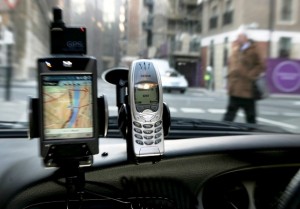Distracted driving is a recognized problem – with nine deaths each day – and it is not limited to texting teens, but includes where are those drivers most likely to be traveling the roads, which appears mostly likely to be somewhere on the East Coast.
A new study shows that East Coast drivers are more likely to engage in some form of distracted driving than those on the West Coast. When broken down by city and state, Miami drivers top the list and New Jersey drivers hold the “state” title.
Miami drivers were likely to use their phones once every four miles whereas Denver drivers, which finished at the bottom of the list, were likely to use their phones just once ever 6.25 miles. The aforementioned New Jersey drivers used their phones once ever 4.7 miles. Wyoming residents used theirs just once every 7 miles.
The findings come from the “Heads Up, Phones Down: Distracted Driving Intervention” report. It looked at a total of 45 billion miles driven by Life360 users and claims to be the largest distracted driving survey to date.
(EPA rolling back CAFE setting up showdown with California. Click Here for the story.)
The top five “distracted” cities are Miami, New York City, Tampa, Atlanta and Orlando. The least distracted five are Denver, Oakland, San Francisco, Chicago and San Antonio. The most distracted states were New Jersey, Florida, Mississippi, New York and Rhode Island. The lowest five states were Wyoming, New Mexico, Idaho, Utah and Montana.
Distracted drivers – as measured by significant interactions with a phone’s screen while driving a vehicle – create a variety of problems. They were found to be four times more likely to speed and 40% more likely to hard break than those who were not distracted.
The highest number of distracted driving incidents happen between noon and 3 p.m., while the lowest number of distracted driving incidents happen between midnight and 3 a.m. Drivers are two times more likely to use their phones during rush hour (4-6 p.m.) than in the early morning (1-3 a.m.).
Perhaps the most surprising statistic coming from the study is that parents are nearly as bad young drivers when it comes to distracted driving and even worse when their expectations are closely examined.
(Click Here to check out the dozen best debuts at the 2018 NY Auto Show.)
Fifty percent of parents have knowingly texted their teen while they are driving, and 29% of parents expect a response before their teen reaches their destination. Most importantly, teens are only 6% more likely to engaged in distracted driving behaviors than their parents.
“As parents, we give teens a hard time about being on their phones while driving, but we aren’t much better,” said Chris Hulls, CEO and co-founder at Life360. “Parents need to be better role models for their kids and can begin by making the necessary changes to their own driving habits. We can save thousands of lives that are lost each year due to distracting driving as a result.”
The group offers “TIPS” for improving distracted driving behaviors:
- “Tell” friends and family before they get behind the wheel so they don’t text or call.
- “Ignore” incoming messages.
- “Pull Over” if responding is a must.
- “Stash” the phone in the glove compartment while driving.
(To see more about luxury automakers shifting focus on plug-in hybrids to performance, Click Here.)
Fifteen states, D.C., Puerto Rico, Guam and the U.S. Virgin Islands prohibit all drivers from using hand-held cell phones while driving. Thirty-eight states and D.C. ban all cell phone use by novice or teen drivers. Twenty-one states and D.C. prohibit any cell phone use for school bus drivers. Though there several variations of rules in place, this report is evidence that changes in legislation are not enough.

